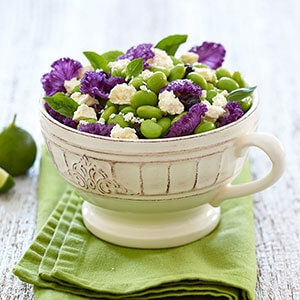Lamb Burgers with Feta Yogurt Topping Recipe
Discover the best recipe for Lamb Burgers with Feta Yogurt Topping using our Tre Stelle recipe gallery! The feta yogurt topping is reminiscent of tzatziki.
Prep Time:45 minutes Ready In:
1 hour or less Serves:
Makes 4 burgers
Ingredients:
1 1/2 lbs ground lamb 1 small onion, chopped finely 1 clove garlic, chopped finely 1 tsp | 5 mL dried oregano 1/4 tsp | 1 mL cumin 4 pocketless Greek Style Pita bread or hamburger buns Feta Yogurt Topping: 1 cup | 250 g plain yogurt 1 clove garlic, minced 1 tbsp | 15 mL lemon juice 1 tbsp | 15 mL white wine vinegar 3/4 cup | 175 mL Tre Stelle® Crumbled Feta
Instructions:
Mix ground lamb with onion, garlic, oregano and cumin and form into 4 patties approximately 1/2” thick. Refrigerate until ready to grill. In a medium bowl mix together yogurt, garlic, lemon juice, vinegar and crumbled feta. Cover and refrigerate until ready to use. Preheat barbeque or indoor grill. Cook burgers approximately 3-5 minutes per side or until cooked to desired doneness. Remove from grill. Fold pita bread in half and place a burger into the middle, top generously with Feta Yogurt topping. Garnish with lemon zest if desired.
Other recipes for:
lamb onion burgerCreated by: Tre Stelle® Kitchen
Cheese: Feta
How to store this easy yogurt feta dressing?
It’s important you store your yogurt feta dressing correctly to prevent it from going bad. Otherwise, there might be some serious consequences, especially because you would be eating spoiled feta cheese. Eating feta cheese that’s gone bad can lead to stomach aches or listeria food poisoning.
There are many ways you can store yogurt feta dressing to ensure it stays fresh and tasty whenever you need it. The shelf life of feta cheese varies based on how it was packaged originally. An unopened package of feta cheese can last about a week past its printed date on the packaging. Once you open your feta cheese, the shelf life reduces and can typically last around five days to a week regardless of the printed date.
You should always store any type of cheese or food that contains cheese in the refrigerator regardless of whether the package is open or closed. This helps prevent spoilage for as long as possible. If you put feta cheese in your yogurt dressing, you should store it in an airtight container. You can leave it in the fridge for up to five days. If the yogurt dressing starts to mold or smell bad for five days, it’s best to toss it in the garbage to prevent food poisoning.
An easy airtight container that most households have is a tupperware container. You can pour your freshly made yogurt feta dressing or any leftover dressing in different sizes of tupperware containers. The lid seals the container and protects your yogurt dressing from being exposed. You can also buy food jars or mason jars from your local container store or large retail store. These containers also have the ability to keep your food safe and fresh over multiple days.
What is the difference between different types of feta cheese?
There are several different types of feta cheese you can find at the grocery store or prepare at home. It also depends on how you prefer to eat your feta cheese and the type of recipe you’re making. Here is a comparison of different types of feta cheese:
Greek feta
Greek feta is probably the most familiar to you. It’s often found in many Mediterranean dishes, such as salads and baked feta recipes. Greek feta is made of at least 70% sheep’s milk and the remaining percentage is typically goat’s milk. The milk used is usually pasteurized but can also be raw. Greek feta cheese has a salty and tangy taste with a dry and crumbly texture.
Danish feta
Danish feta, also called Danish White, is made mostly from cow’s milk and has a creamier texture than Greek feta cheese. It also has a milder taste and can be sliced without crumbling. This makes it perfect for dishes that require cubes of cheese, such as on salads or grille dishes.
Most Danish feta cheeses are made using the ultrafiltration method. Pasteurized milk passes through a special filter, which results in a concentrated and viscous liquid. Starter bacteria is added to the liquid, and it eventually turns into a solid. You can lightly salt the cheese to taste. Ultrafiltration is a faster method of producing feta cheese.
Bulgarian feta
Bulgarian feta is made of sheep’s milk and a yogurt culture. It’s softer and more slippery than Greek feta but shares a tangy taste. Bulgarian feta cheese has a particularly grainy texture that’s more crumbly as well.
Australian feta
Australian feta is usually made from cow’s milk and has varying textures and flavors. Many people that eat Australian feta enjoy the combination of saltiness from Greek feta and creaminess from Danish feta.
Marinated feta
When you marinate feta in different ingredients, such as olive oil, lemon, and spices, it gives the cheese an entirely different flavor. It can be used to garnish salad, on top of pizzas, in yogurt dressings, and much more.













